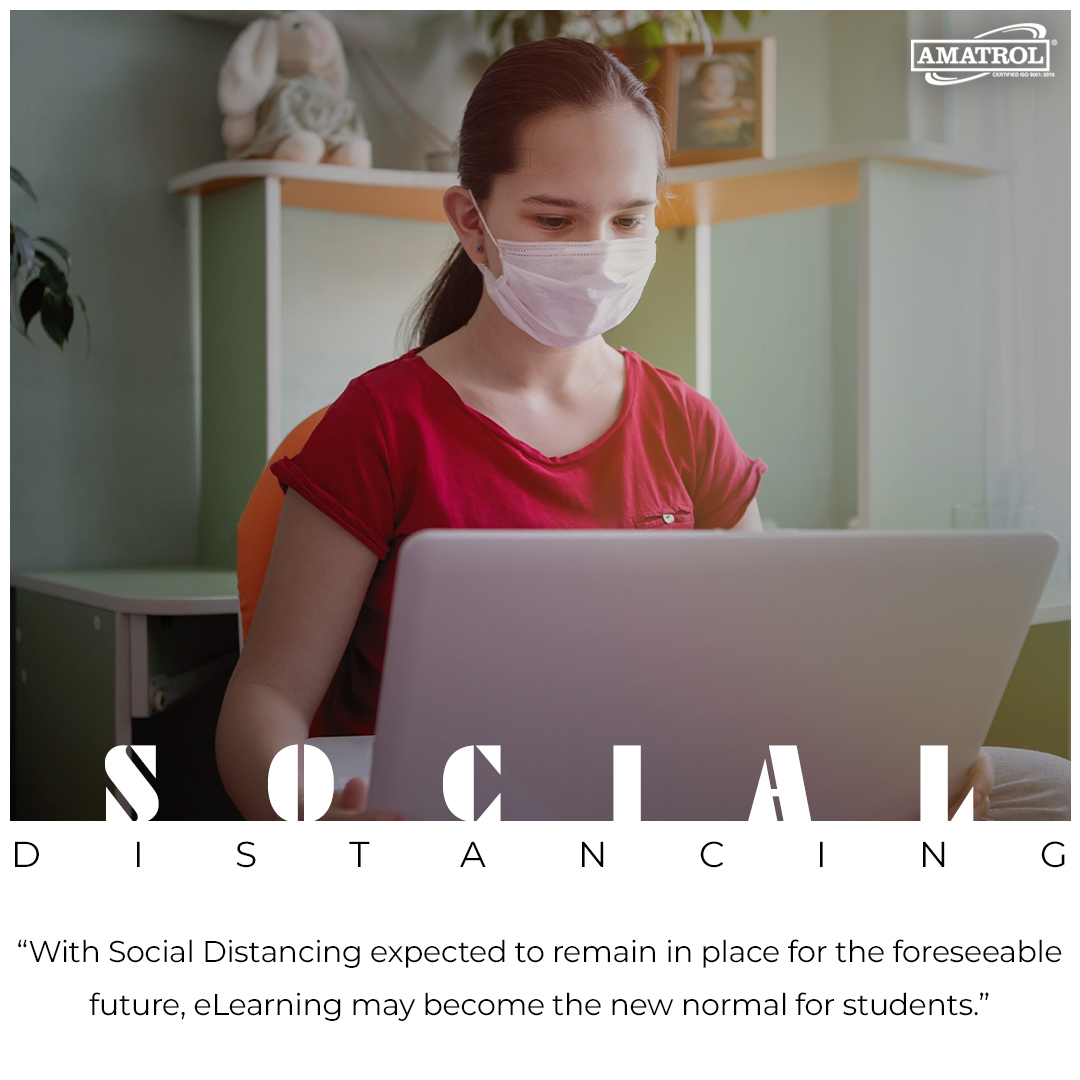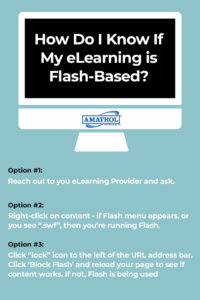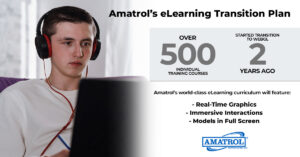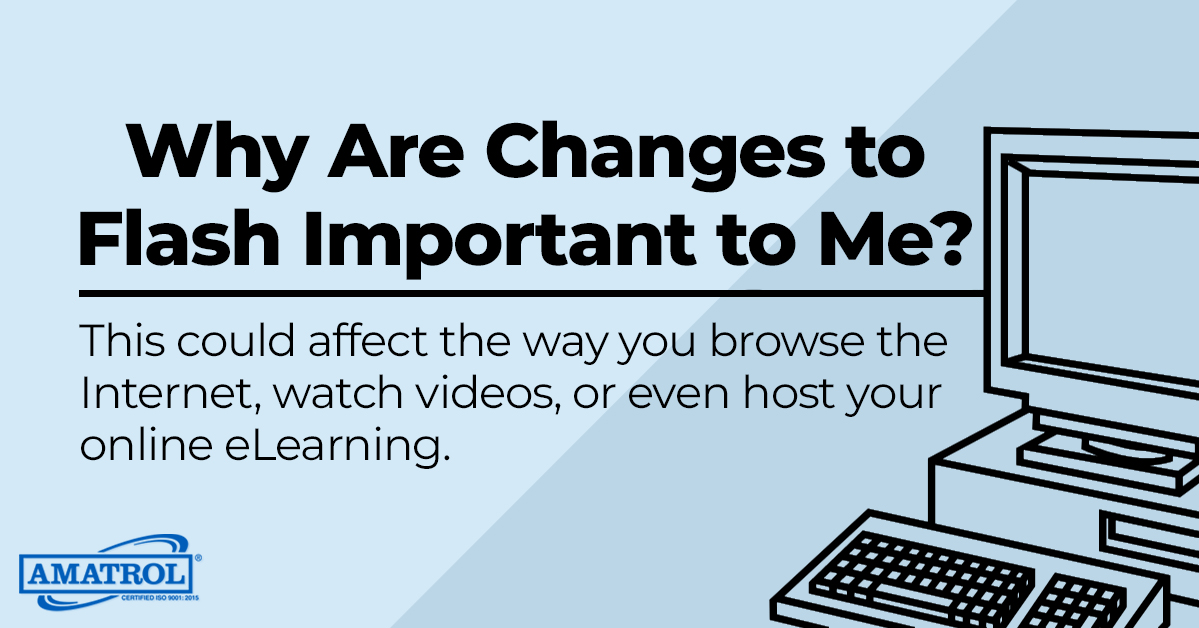NOTE: If Amatrol is your eLearning provider, or you are considering Amatrol as a provider, click here to see Amatrol’s eLearning Transition Plan.
While speculation had been tossed around for some time, Adobe recently announced that all online Flash-based products will be completely removed from all browsers by Dec. 31, 2020.
Flash, which began all the way back in 1996, quickly became the standard for Web video after the popular streaming site YouTube chose the software platform to run its video and animations. Despite early accolades, user security concerns hindered its growth, leaving major conglomerates (such as Apple) refusing to carry the platform. With whispers of the platform’s eventual demise circulating, Adobe decided that instead of trying to fix the complex security issues, a complete overhaul was necessary instead.
While the news wasn’t completely unexpected, it left some wondering how this could affect their daily lives. Now, thanks to the current climate of social distancing and online learning due to the COVID-19 pandemic, many instructors had to make a quick decision to implement eLearning, and are now scrambling to find out if the lights will go out on their eLearning platform by year’s end.
The Skinny: Why are Changes to Flash Important to Me?
Well, this could affect the way you browse the Internet, watch videos, or even host your online eLearning.
But before diving too deep into the changes that you will see, it’s important to note the good news that we will experience with Flash’s removal: web browsing should becoming safer, faster, and smoother without it.
Beginning Jan. 1, 2021, Adobe will stop updating and distributing Flash, meaning all Flash-based products on any website will cease to work. Outdated versions of the platform were becoming main targets for hackers, and because of how Flash was created, it offered many ways criminals could get into their target’s machines, stealing valuable information.
With the collapse of Flash, Industry is now shifting to other online platforms, such as WebGL and HTML5. Both programs provide the opportunity for your browser to access more of your computer’s hardware, which can dramatically increase performance and rendering speeds. Ultimately, this change will allow programs to produce larger, higher quality content that run faster and smoother.
However, as mentioned previously, this change in graphics standards could affect how your eLearning software runs. So here are a few questions to ask yourself in preparation of Flash’s retirement at the end of 2020:
Why Is This the End of Flash Such a Big Deal for eLearning?
Flash technology has been instrumental in creating interactivity for almost all eLearning providers at one point or another. When Flash ends and finally disappears for good, these courses will not function. This could affect every program that relies on eLearning, which has already been a hot topic in 2020.
With COVID-19 forcing schools worldwide to online distance learning, many schools have opted to utilize online curriculum to finish out the academic year. With concerns that the virus could flare back up in the Fall and Winter, paired with Flash ending Dec. 31, this could create major problems for programs that aren’t prepared.
With Social Distancing expected to remain in place for the foreseeable future, eLearning may become the new normal for students. Whether school is in session – and classes are using it to separate students out – or the learning is taking place from home, eLearning could be the immediate future of academics. Without it, how are our students learning?
So ensuring students are still actively learning is not only vital for Industry, but for the future of our nation.
How Do I Know If My eLearning is Flash-Based?

Unless your platform has undergone recent updates to their systems, chances are at least some of your eLearning will have Flash-based graphics and interactions.
There are a few different ways to find out if your eLearning is Flash-based. The first option is to check manually. With your eLearning software open, right-click on what you believe to be Flash content. If you see a Flash context menu appear, or if you see “.swf” when you search the source, then you are indeed running Flash.
A second way to check on Flash technology is to click on the small “lock” icon to the left of the URL address bar. A menu will appear that has Flash listed. Set the Flash option to ‘Block’ and reload your page to see if the content works. If it doesn’t, then Flash technology is being utilized. (And don’t forget to change your settings back!)
Finally, don’t hesitate to reach out to your provider and ask them. Hopefully, they have been transparent enough to give you updates on their approach to these impending changes.
Finally, there are numerous free websites that can tell you what version of Flash your browser is using. But remember, if your provider doesn’t plan to update their curriculum from Flash-based graphics, then the eLearning may become a simple page-turner, or just plainly fail to work.
What If My eLearning Contains Flash?
If your eLearning platform contains Flash, hopefully your provider already has a plan in motion.
Re-programming an entire library of eLearning courses to move away from Flash isn’t done with the click of a button. The amount of work to locate, re-program, and implement new eLearning is immense, forcing many providers to take the easy route and simply remove interactive Flash content. While this will allow the training to run, it will become an infinitely less interesting course, as the only interaction is turning the page.
So when considering your platform’s eLearning transition plan, don’t be afraid to ask them about their approach to the upgrade, such as:
- Are you making plans to transition away from Flash?
- How will the interactivity differ from the Flash version?
- Will it still look the same?
- When will it be available?
- If my course has not been transitioned yet, can I have access to a course that has been for evaluation?
- What is your plan on courses moving forward?
If your provider doesn’t yet have a plan in place, or can’t answer one of those previous questions, then it may be time to consider an alternative provider.
What Should I Look For in a Post-Flash eLearning World?
Preparedness.
Simply put, this “news” about Flash’s transition to obscurity is not new information. So if a provider doesn’t have a plan in place, or are still sorting through some of the details, chances are they won’t be able to finish transitioning their curriculum from Flash. (Or, if they do rush to finish, the interactivity might be lacking.)
So when looking for a provider in a post-Flash world, consider going with one that had a plan in place for this transition. If they did, then chances are their curriculum won’t simply be a page-turner version, offering no academic value to the student.
While this article on eLearning Misconceptions might offer more detailed advice, make sure your future eLearning company has eLearning curriculum, quality assessment, and hands-on learning capabilities, even Virtual components. Without comprehensive curriculum or assessment of job-ready skills, then there is no true ruler for evaluating if students are learning the correct skills.
Also, ask questions. Request of any provider you’re considering for a no-obligation, full-access trial of their complete eLearning library – not just a sample reel they have hand-selected. This will allow you the opportunity to take a deep-dive into the entire curriculum, leaving you with a much better understanding of their eLearning products.
Amatrol’s eLearning Transition Plan

With our massive interactive eLearning library – containing over 500 individual training courses — we started our transition from Flash to WebGL over two years ago. The goal was to ensure that our customers will have the same high level of interactivity that Amatrol is known for worldwide.
Thanks to WebGL’s new development platform, our world-class eLearning curriculum is getting even better. Real-time graphics open the door for more immersive interactions, and engaging visuals and models.
For current Amatrol eLearning customers, we are rolling out WebGL-based eLearning titles alongside their Flash-based counterparts daily, and will continue to do so until all current courses have been converted, which will be done well before Dec. 31. WebGL does require slightly different computer/browser requirements, including 8GB of RAM, a soundcard or onboard sound, a video card or onboard video, a 64-bit browser, and broadband internet access capable of 1Mbps. WebGL also operates optimally using Windows 64-bit operating system.
When Jan. 1, 2021 rolls around, the latest version of 536 eLearning courses will automatically switch over to the WebGL versions, including those using the latest versions of SCORM. However, prior versions of Amatrol course will not be transitioned to WebGL and will not be available in the new year.
For customers needing to stick with previous curriculum versions due to having a mix of new and old training systems, there are options.
First, customers could move their courses to the current versions. For example, Amatrol’s Motor Control training system (85-MT5) utilizes several components, including a multifunction timer that recently had to be updated. This resulted in a new version of the curriculum and skills. If customers wish to use the new version of the curriculum with revised skills, they could update their system with a new multifunction timer panel. Alternately, they could switch to the new curriculum and continue using the skill directions that they currently have for their trainer.
If that option isn’t ideal, Amatrol will offer multimedia rental for local installation access. While Flash is disappearing from web-based applications, the Flash Player will still work on applications installed on customer computers, allowing learners to continue to use older versions of courses – these, however, will not be able to be delivered over the internet or otherwise broadcast.
Local Amatrol distributors can assist customers in transitioning from an online eLearning lease to renting curriculum for local installation when it becomes available later in the summer. If customers select the locally-installed option, Amatrol offers Skill Trace for skill tracking and quiz delivery. For any assistance in identifying the best solution for your situation or any other assistance in matters related to this transition, please don’t hesitate to contact your Market Services Representative.
About Wes Scott
Wes Scott is a former public high school teacher and journalist. He is currently a Marketing Content Developer for Amatrol, Inc. Learn more about Amatrol and its technical training solutions, including eLearning, here and connect with Wes on Amatrol’s Twitter, Facebook, LinkedIn, and YouTube pages.






